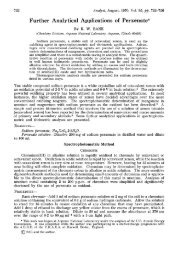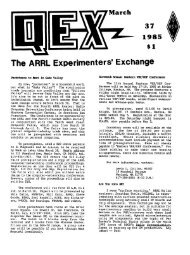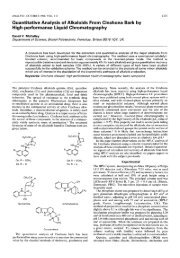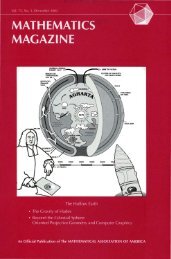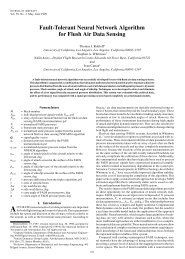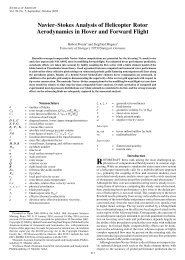pdf 6436KB Sep 25 2010 04
pdf 6436KB Sep 25 2010 04
pdf 6436KB Sep 25 2010 04
- TAGS
- 81.70.242.211
You also want an ePaper? Increase the reach of your titles
YUMPU automatically turns print PDFs into web optimized ePapers that Google loves.
NCJ Review: The Elecraft K3<br />
Revisited<br />
A year ago, NCJ presented a contester’s<br />
perspective on a pre-production version of<br />
the new Elecraft K3 (“NCJ Reviews: The<br />
Elecraft K3 — First Impressions,” <strong>Sep</strong>/Oct<br />
2007 NCJ). The review radio was great, but<br />
it lacked some important features in terms of<br />
both hardware and fi rmware. This article updates<br />
those fi rst impressions, commenting<br />
on production version differences, added<br />
components and features, the assembly<br />
and support experience and published lab<br />
tests. It also editorializes a bit on software<br />
defi ned and modular radio experiences that<br />
might be of importance to contesters.<br />
Production Release<br />
Subsequent to the fi eld test review, Elecraft<br />
released many additional items, fi rst<br />
to the testers and then, after ironing out<br />
the wrinkles, to general availability. When<br />
the first K3 production run shipped in<br />
October 2007, the radio included a 100W<br />
power amplifi er, hardware noise blanker<br />
and a higher-precision TCXO. Rigs were<br />
available either factory-assembled or as a<br />
no-solder semi-kit. Later, Elecraft released<br />
a full-function sub-receiver, additional fi lters<br />
and many fi rmware upgrades. The last<br />
included FM, ESSB, auto notch, selectivity<br />
presets, diversity receive and continuous<br />
improvement of nearly everything. Delivery<br />
delays have declined to about three<br />
months, and Elecraft continues to work on<br />
production processes in order to reduce<br />
the backlog.<br />
Elecraft zealots report deliveries on the<br />
company refl ector (elecraft@mailman.<br />
qth.net) and track them via an independent<br />
Wiki, www.zerobeat.net/mediawiki/<br />
index.php. The Wiki includes product<br />
descriptions and resource material. By<br />
unoffi cial count, Elecraft had shipped more<br />
than 1800 K3s through <strong>Sep</strong>tember 2008.<br />
Hardware Additions and Corrections<br />
Very few updates were needed to bring<br />
fi eld test units up to production standards. I<br />
made most of the modifi cations in the fi eld,<br />
and today I can barely distinguish between<br />
my fi eld test unit (serial no 12, June 2007)<br />
and the full-production radio I built in April<br />
2008 (serial no 744).<br />
The most significant feature absent<br />
from my fi eld test radio was the 100 W<br />
power amplifi er. The K3’s PA is considerably<br />
lighter than the one in the K2, and<br />
it’s very easy to install. The heat sink is<br />
entirely inside the K3 case, cooled by two<br />
large, rear-mounted fans. These variablespeed<br />
fans are temperature controlled and<br />
6 November/December 2008 NCJ<br />
quieter than those in my laptop. I literally<br />
never hear them.<br />
The K3 PA has very level power output,<br />
thanks to a strong ALC algorithm that<br />
evolved nicely during fi eld testing. Power<br />
foldback in response to high reflected<br />
power is gradual and effective. Below an<br />
SWR of 2.5:1, I can get 100 to 120 W output<br />
on 160 through 6 meters. An informal<br />
check at 3.5:1 showed 50 W out. If you<br />
reduce the target power below 13 W, the<br />
100 W PA shuts down altogether, and you<br />
have a very effi cient QRP rig.<br />
Sub-Receiver<br />
The most important addition in the<br />
wake of the K3’s initial release is the<br />
KRX3 sub-receiver. Initially, Elecraft was<br />
not satisfi ed with signal isolation between<br />
the main rig and the prototype KRX3.<br />
The manufacturer delayed shipment for<br />
several months while it designed a full<br />
wraparound steel enclosure, tested it and<br />
got it into production. The delay was well<br />
worth it. The sub-receiver is, as advertised,<br />
every bit as good as the main receiver. In<br />
fact, its additional shielding may make it<br />
slightly more immune to external noise<br />
and unwanted signals than the alreadyoutstanding<br />
primary receiver.<br />
The sub-receiver has its own DSP, synthe-<br />
Rick Tavan, N6XI<br />
Elecraft with permission<br />
Figure 1 — The KRX3 sub-receiver open; the KPA3 power amplifi er is at top center.<br />
sizer, noise blanker and sockets for up to fi ve<br />
crystal roofi ng fi lters. Although some owners<br />
have equipped the KRX3 with a full fi lter<br />
complement, matching the main receiver, I<br />
haven’t found that necessary. So far, I am<br />
just using the included 2.7 kHz fi ve-pole fi lter.<br />
Since ultimate selectivity is DSP-derived,<br />
this is acceptable except in the presence of<br />
very strong, nearby signals.<br />
The 2.7 kHz fi lter is essentially indistinguishable<br />
from the 2.8 kHz eight-pole fi lter<br />
in my main receiver except when attempting<br />
diversity reception. Because of different<br />
delays through those fi lters, there is a funny<br />
phase shift that’s quite audible in the headphones<br />
when the two receivers are tuned<br />
to the exact same frequency. This latency<br />
disappears when listening to different frequencies,<br />
as in a DX pileup, my primary use<br />
for the sub-receiver. Phase shift is not an<br />
issue when the two receivers are equipped<br />
with matching fi lters. I intend to reconfi gure<br />
my fi lters so that the two receivers have<br />
some in common — probably 2.7 and 1.0<br />
kHz. Although it’s not diffi cult to add and<br />
exchange fi lters, the KRX3 does introduce<br />
additional disassembly to this process.<br />
The K3 is no longer a svelte eight<br />
pounder. The heavily shielded KRX3 has<br />
pushed a fully-loaded K3 up to almost ten<br />
pounds. Some people like that, since the



